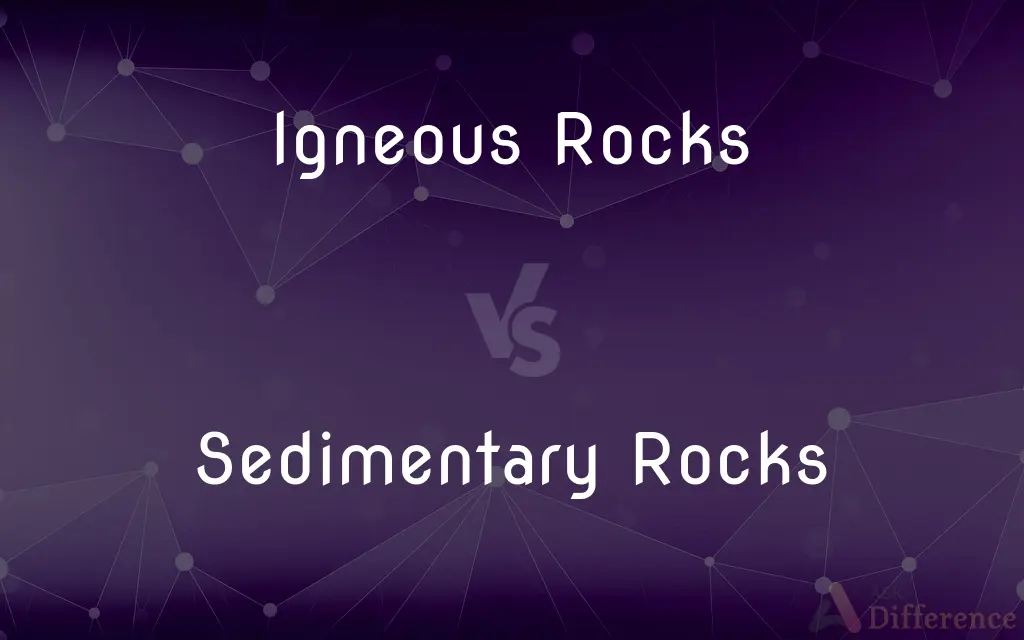Igneous Rocks vs. Sedimentary Rocks — What's the Difference?
By Tayyaba Rehman — Published on January 28, 2024
Igneous rocks form from cooled magma or lava, while sedimentary rocks are made from compacted sediment like minerals, organic matter, or fragments of other rocks.

Difference Between Igneous Rocks and Sedimentary Rocks
Table of Contents
ADVERTISEMENT
Key Differences
Igneous rocks are formed from the solidification of magma or lava. This can happen beneath the Earth's surface, forming intrusive igneous rocks like granite, or on the surface as extrusive igneous rocks like basalt. Sedimentary rocks, on the other hand, are formed through the deposition and compaction of sediment. This sediment can include mineral particles, organic matter, or fragments of other rocks and is often laid down in layers.
The formation process of igneous rocks involves cooling and solidification, which can create a variety of textures and compositions based on the cooling rate and chemical composition of the magma or lava. Sedimentary rocks are formed through processes like weathering, erosion, deposition, and compaction, often resulting in layered structures and containing fossils.
Igneous rocks are generally hard and dense due to their crystalline structure formed from cooling magma or lava. Sedimentary rocks can vary widely in hardness and density, depending on the type and amount of sediment they are composed of, as well as the degree of compaction and cementation.
In terms of location, igneous rocks are often found in areas with volcanic activity or where there has been historical volcanic activity. Sedimentary rocks are typically found in environments like river beds, ocean floors, and deserts, where sediment can accumulate over time.
The study of igneous rocks helps geologists understand volcanic processes and the Earth's interior, while sedimentary rocks provide insights into the Earth's surface processes, including past environments and life, due to the presence of fossils.
ADVERTISEMENT
Comparison Chart
Formation Process
Cooling and solidification of magma/lava
Compaction and cementation of sediment
Texture and Structure
Crystalline, can be fine-grained or coarse
Often layered, can contain fossils
Hardness and Density
Generally hard and dense
Varies widely, can be less dense
Common Locations
Volcanic areas, both above and below ground
River beds, ocean floors, deserts
Geological Significance
Indicate volcanic processes, Earth's interior
Show Earth's surface processes, past environments
Compare with Definitions
Igneous Rocks
Indicates past volcanic activity.
The presence of igneous rocks suggests historical volcanic activity in this area.
Sedimentary Rocks
Formed through weathering and erosion.
Rivers contribute to the formation of sedimentary rocks by carrying sediment.
Igneous Rocks
Varied textures based on cooling rate.
Obsidian, a glassy igneous rock, cools rapidly.
Sedimentary Rocks
Made from compacted sediment.
Sandstone is a sedimentary rock formed from compacted sand.
Igneous Rocks
Can be intrusive or extrusive.
Basalt is an extrusive igneous rock formed from lava.
Sedimentary Rocks
Typically found in layered deposits.
The layered structure of sedimentary rocks is visible in cliff faces.
Igneous Rocks
Characterized by a crystalline structure.
Igneous rocks often have visible crystals in their composition.
Sedimentary Rocks
Often contains fossils.
Sedimentary rocks like limestone can hold ancient fossils.
Igneous Rocks
Formed from cooled magma or lava.
Granite, an igneous rock, is commonly used in countertops.
Sedimentary Rocks
Reveals information about past environments.
Sedimentary rocks can tell us about Earth's surface history.
Common Curiosities
What type of igneous rock is granite?
It's an intrusive igneous rock.
What causes the texture in igneous rocks?
The rate at which magma or lava cools.
What are igneous rocks made of?
Solidified magma or lava.
Are fossils found in igneous rocks?
No, fossils are typically found in sedimentary rocks.
Are all igneous rocks hard and dense?
Most are, but some can be less dense.
How are sedimentary rocks formed?
From compacted and cemented sediments.
Can igneous rocks be found underground?
Yes, as intrusive igneous rocks.
Can sedimentary rocks form under water?
Yes, many form in aquatic environments.
Can sedimentary rocks form in deserts?
Yes, through processes like wind erosion and deposition.
Do sedimentary rocks always have layers?
They often do, but not always.
Do igneous rocks indicate volcanic activity?
Yes, they are associated with volcanic processes.
How can sedimentary rocks be identified?
Often by their layered appearance and the presence of fossils.
What information can sedimentary rocks provide?
Insights into past environments and life.
What is an example of an extrusive igneous rock?
Basalt, formed from rapidly cooled lava.
Are igneous rocks used in construction?
Yes, materials like granite are popular in construction.
Share Your Discovery

Previous Comparison
Active Filter vs. Passive Filter
Next Comparison
Sandals vs. FloatersAuthor Spotlight
Written by
Tayyaba RehmanTayyaba Rehman is a distinguished writer, currently serving as a primary contributor to askdifference.com. As a researcher in semantics and etymology, Tayyaba's passion for the complexity of languages and their distinctions has found a perfect home on the platform. Tayyaba delves into the intricacies of language, distinguishing between commonly confused words and phrases, thereby providing clarity for readers worldwide.
















































